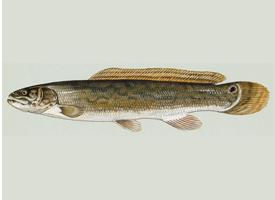
Description de l'animal
The Bowfin (Amia calva) is a fascinating and unique species of fish that inhabits the freshwaters of North America. Known for its resilience and ancient lineage, the Bowfin has intrigued scientists and fishermen alike for centuries. This remarkable fish boasts a series of characteristics and behaviors that set it apart from other freshwater species, making it an interesting subject of study and observation.Physically, the Bowfin presents a prehistoric appearance, reminiscent of the Jurassic era, a testament to its ancient origins. It has a long, cylindrical body that can reach up to 109 cm in length, although most specimens are typically smaller. The body is covered in thick, bony scales that provide protection against predators and environmental hazards. One of the most distinctive features of the Bowfin is its dorsal fin, which runs almost the entire length of its back, giving it a formidable look. This fin is used for stabilization and maneuvering in the water. The coloration of the Bowfin is generally dark, with patterns of green, brown, and black, which help it camouflage in its natural habitat.
The Bowfin's head is broad and flat, with a powerful jaw lined with sharp teeth, indicative of its predatory nature. Its eyes are situated on top of its head, allowing it to see prey above it while remaining submerged. Another remarkable feature of the Bowfin is its gas bladder, which functions similarly to a lung. This adaptation allows the Bowfin to breathe atmospheric air, enabling it to survive in low-oxygen environments where other fish would perish. This ability to gulp air from the surface is particularly useful during the hot summer months when oxygen levels in the water can drop significantly.
In terms of habitat, the Bowfin is highly adaptable and can be found in a variety of freshwater environments across Eastern North America, from the Great Lakes region down to the Gulf of Mexico. It prefers slow-moving or stagnant waters with abundant vegetation, such as swamps, marshes, and muddy backwaters of rivers. The dense vegetation not only provides the Bowfin with ample cover to ambush prey but also supports a rich ecosystem where it can find food.
The diet of the Bowfin is as versatile as its habitat. It is a voracious predator, feeding on a wide array of prey, including fish, crustaceans, and insects. Its hunting strategy is one of stealth and power, relying on its camouflaged appearance to ambush unsuspecting prey, which it then grasps with its strong jaws.
Reproduction for the Bowfin occurs in the spring when water temperatures rise. The males construct nests in shallow waters, often in densely vegetated areas, to attract females. After spawning, the male Bowfin exhibits a rare level of parental care among fish by guarding the eggs and later the young fry against predators. This protective behavior ensures a higher survival rate for the offspring.
Despite its robustness and adaptability, the Bowfin faces threats from habitat destruction and pollution. However, it is not currently listed as endangered. In some areas, it is even considered a nuisance due to its predatory nature, which can affect populations of other game fish.
In conclusion, the Bowfin (Amia calva) is a remarkable survivor from an ancient lineage, equipped with unique adaptations that have enabled it to thrive in diverse freshwater environments. Its prehistoric appearance, predatory habits, and unusual reproductive behaviors make it a fascinating subject for those interested in the natural world. As a species that has endured for millions of years, the Bowfin serves as a living link to the distant past of our planet's aquatic ecosystems.
Nouvelles photos d'animaux
Top 10 des animaux
- Dolphin gull (Leucophaeus scoresbii)
- Japanese macaque (Macaca fuscata)
- Greek tortoise (Testudo graeca)
- Stone loach (Barbatula barbatula)
- Galápagos tortoise (Geochelone nigra complex)
- Russian tortoise (Testudo horsfieldii)
- Diana monkey (Cercopithecus diana)
- Moustached guenon (Cercopithecus cephus)
- Common flying dragon (Draco volans)
- Galápagos penguin (Spheniscus mendiculus)